Your chickens will need properly formulated chicken feed that is the correct type for their age, for growth, sustenance and to produce eggs if they are hens of egg laying age. There are many old wives tales and alternative views on feeding, some say it’s marketing that has created all of these feeds and hens will survive well on wheat and others will say their grandad never had layers pellets and just fed his hens kitchen scraps! Formulated poultry feeds didn’t exist until recently, primarily created thanks to commercial research on hens diets as we tried to squeeze more and more eggs out of hens.
In days gone by though when ‘grandad fed scraps’, pure breeds were kept for eggs and they were fed grain mixes or dried mash chicken feed that had meat or fish meal added to increase the protein content. Hens would free range over a large area and could also supplement their diet with what they could forage. Bugs, insects and worms are all valuable sources of protein, not forgetting a good selection of greens providing vitamins and minerals.
“Grandad’s chickens didn’t get chicken feed and survived on kitchen scraps but they could free range to top up their diet on protein, vitamins, minerals and calcium from the fields or orchards they grazed. They didn’t produce anything like the number of eggs modern hybrid hens or some pure breeds produce.”
So in short, if you don’t feed a proper formulated layers feed to your hens, they won’t be able to keep up the demands that egg-laying puts on their bodies.
Layers Feeds and Protein
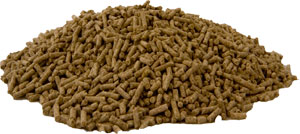 Chickens require protein to produce feathers and eggs as well as to grow. The amount of protein in their diet is important and you will see on the ingredients on the back of bags of commercial feeds the percentage of protein that they contain. It is higher in ‘Growers Pellets’ for example to enable chickens to grow and produce feathers. You will find that chickens stop laying eggs when they moult (lose their feathers and regrow new) as they are diverting protein from egg production to feather production. During the moult, you can scatter a handful of cat kibble in the run which helps them to top up with protein. Do not use dog food as most of the protein is derived from cereals.
Chickens require protein to produce feathers and eggs as well as to grow. The amount of protein in their diet is important and you will see on the ingredients on the back of bags of commercial feeds the percentage of protein that they contain. It is higher in ‘Growers Pellets’ for example to enable chickens to grow and produce feathers. You will find that chickens stop laying eggs when they moult (lose their feathers and regrow new) as they are diverting protein from egg production to feather production. During the moult, you can scatter a handful of cat kibble in the run which helps them to top up with protein. Do not use dog food as most of the protein is derived from cereals.
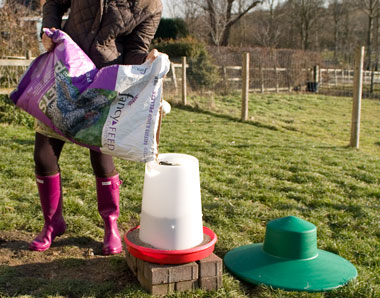
Commercial feeds contain the right balance of nutrients & can be fed ad-lib in hoppers if kept dry. This one has a rain hat.
Commercial chicken feeds have been well researched and contain the correct balance of minerals and nutriets required by chickens as well as sufficient protein and calcium which is essential for egg shell production. Layers pellets for example are around 16% protein. Wheat is about 10% protein and lacks essential vitamins that are required by chickens.
Formulated feeds come as pellets or mash and should be fed ad-lib so hens can take what they want as they need it. This type of feed must be kept dry or it will soon spoil. The feeder and rain hat shown above is the only sort I have found that really does keep the feed dry. Most have a hole in the top of the hat for a handle or for hanging and this lets water in. A feeder and rain hat similar to this one can be bought from Omlet.
Eggs are made up of around 80% protein so if there’s a shortage of protein in their diet, egg laying will be the first thing they your girls cut back on!
There is more information on the poultykeeper.com site which has a very good page of feeding chickens and chicken feed.
Mixed corn
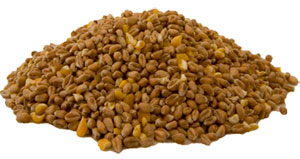 Mixed corn is usually 80 to 90% wheat and 10 to 20% maize. It is useful as a scratch feed, it keeps hens active, scratching around looking for it but should only be considered a treat. A handful per hen thrown late afternoon helps them to have a full crop overnight.
Mixed corn is usually 80 to 90% wheat and 10 to 20% maize. It is useful as a scratch feed, it keeps hens active, scratching around looking for it but should only be considered a treat. A handful per hen thrown late afternoon helps them to have a full crop overnight.
The maize (yellow in colour) is very fattening but can be useful during very cold weather to help your hens keep warm – I increase my girls’ ration of corn when it is cold over the winter, after they have finished moulting (they need lots of protein during the moult) since they are not laying eggs and need a little extra fat to burn in order to keep warm.
If you feed too much corn, your hens will get fat and fat hens don’t lay eggs!
Household scraps
Feeding household scraps is no longer allowed according toi DEFRA and can be a bit hit and miss anyway. You don’t really know what a hen is getting and the diet is very unbalanced. It is for this reason that scraps used to be mixed into a mash by using layers mash and water (which can be warm in winter). The mixture should be a sort of crumbly mix, not too wet but not too dry. Feeding scraps should be limited to at most 25% of a hens diet so as not to tip the balance too far one way or another.
Greens
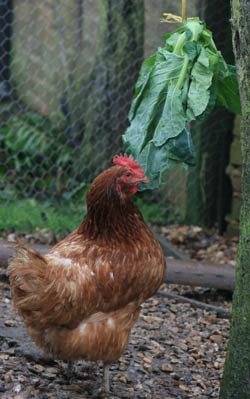 Ample green stuff should be provided for your hens. Grass cuttings, weeds and off-cuts from cabbages, cauliflowers and other greens can be provided at minimal cost. Lettuce should be fed in moderation because it has very little nutritional value (very little Protein and Energy / Calories) and avocado pear is poisonous to hens but most other greens that come from the kitchen will be appreciated by your girls. Try hanging greens in their run, just a little higher than they can reach. As they eat them, they will need to jump to get the last bits so will be getting exercise at the same time as their greens! Win-win!
Ample green stuff should be provided for your hens. Grass cuttings, weeds and off-cuts from cabbages, cauliflowers and other greens can be provided at minimal cost. Lettuce should be fed in moderation because it has very little nutritional value (very little Protein and Energy / Calories) and avocado pear is poisonous to hens but most other greens that come from the kitchen will be appreciated by your girls. Try hanging greens in their run, just a little higher than they can reach. As they eat them, they will need to jump to get the last bits so will be getting exercise at the same time as their greens! Win-win!
If you have an area in which you can grow cabbages in your garden, it may be worthwhile thinking about growing a row for the winter. Cabbages will sit there in the cold, perfectly preserved until picked. You will need to keep them covered with fleece when there are cabbage white butterflies around but don’t worry if they are a little eaten, the chooks won’t mind!
Mealworm treats
Many chicken keepers like to buy mealworms or chicken treats containing these. Chickens love these and are easily tamed by using such tasty treats, however you should keep in mind that animal by-product regulations mean that mealworms are not really allowed to be fed to poultry.

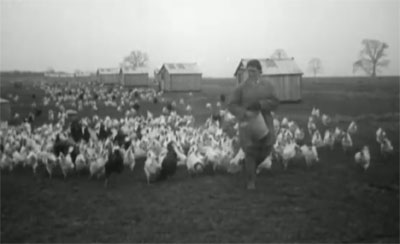
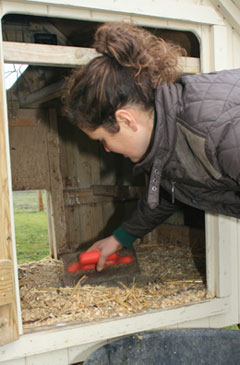
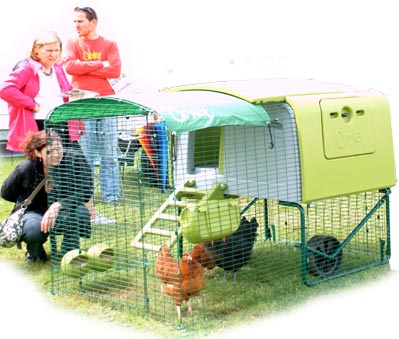
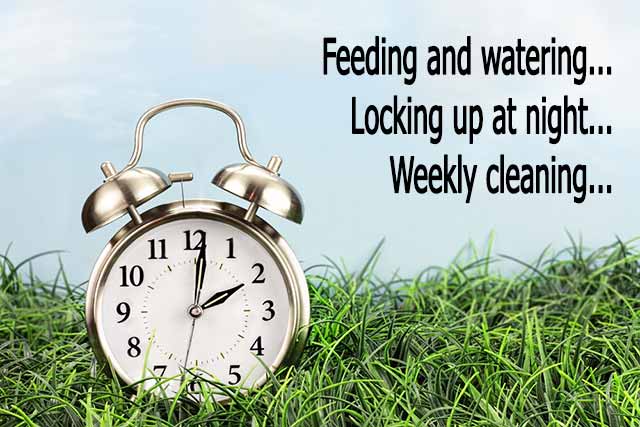
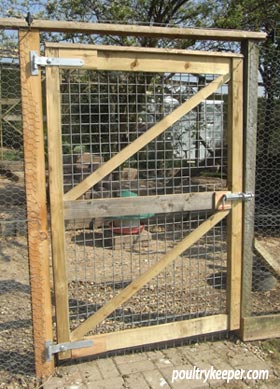
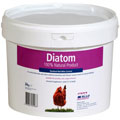
Hi, firstly would like to thank you for making this site which as complete novices has helped us immensley. I do have a question:
We bought 3 hens (21 weeks old) yesterday.. the supplier was wonderful 7 gave us everything we needed. We have put layers pellets in the coop but upto now the girls just seem to want grass.. The pellets have hardly been touched in 24hrs.. Is this normal???? Im pressuming that these hens have never seen grass before as the came out of a huge shed with 100`s of hens inside. On a plus note we have had 2 eggs this morning so all cant be that bad. Will they go to the pellets in their own time or should we consider changing the food???. Thanks
If pellets are ad-lib then, I would say that’s fine – grass (in the spring when fresh) is full of protein and minerals as well as insects (more protein) and can make up a lot of their diet so I would not worry. They will be far more healthier with access to grass.
We have just got 4, 12 week old orpingtons and they are free to roam the garden all day and have just been putting them into the coop on an evening – I have put out chick crumb but they don’t; seem to be eating much of this, instead foraging in the longer grass and under the hedge, should I be worried that they don’t; seem to touch the crumb? We have given them some mixed corn on an evening and they love this and come running up to us when we go out and we an hand feed them this too which is great fun.
Chick crumb shouldn’t be fed to 12 week old birds – they should have growers pellets ad lib. They will top up with other things but should take what they need.
hi i have had 2 chickens for past 3/52 having bought them from their previous owners , they are 2 very healthy and happy chickens that lay an egg every day but they seem to have been fed on chick crumb constantly , it is obvious they preferr this and are picky eaters as despite trying a number of different pellet feeds for layers they simply refuse to eat any of them even when i mix with crumb they pick around the pellets leaving them untouched and the crumb devoured. can i continue to feed them crumb if they refuse to switch to pellets with this have an effect on them health wise and should i supplement the crumb with anything else, i add oyster shell in addition to normal grit currently am i doing the right thing . i am a first time chicken owner and finding my feet currently . thanks
I haven’t had this problem before. If you cut out the crumb and leave them with the other food for a couple of days, they should be hungry enough to start eating it… Sounds like they are just fussy.
Wow, this website is fab!!! We are preparing for the arrival of our first chickens next week and I have several questions.
Firstly, we are getting a hen and 10 chicks as the lady is completely overstocked and didn’t realise the hens had a secret nest (they are free range during the day and a couple went missing and reappeared with chicks!) I have 4 cats who I’m worried will be too interested in the chicks so wondered about keeping them in something like a large dog cage until they are bigger? Is that completely stupid? They will be able to be outside in the run under supervision for a few hours a day, maybe several times. Their eventual home will be a large shed that we are converting which has a huge run (10m long x 5m wide) and also access to an acre of garden.
Secondly, when we put in perches and nest boxes, are they to be on opposite sides? I’m thinking if perches are higher they might poo on the nest boxes if they’re all on the same wall. Again, a stupid question no doubt.
And thirdly, feeding. Since they are just a few weeks old, what should the chicks be getting? And does it matter if the hen eats it instead of her own (layers pellets I presume) as obviously it’ll be hard to make sure they don’t eat each others?
Oh, and related to the first question, if we keep the chicks caged til they are bigger, will the hen be upset at not being in with them? I’m a horsey person and thinking of mares and foals being separated!!
I hope these questions aren’t too dumb. I assure you I am a responsible adult 🙂 I just want to make sure we do it right.
Many thanks!!!
Hen and chicks need to be together now they have bonded. If not they will fret… She also needs to keep them warm.
I would put them into their final coop together if it is a reasonable (shed) size. This should be fine for a few weeks until they are big enough to be of no interest to the cat.
They will need chick crumbs to eat for now and then growers pellets later on.
As long as perches aren’t close to nest boxes, they won’t soil them. When perched, their droppings will fall quite close to the centre of the perch, onto the floor.
Hi I am collecting 1 15 week old pullet and 2 12 week old pullets (pekin bantams) and am not sure what would be best to feed them as they are different ages and need to be on the one coop. Any advice would be greatly appreciated.
Growers pellets until they are about 20 weeks old. Then layers pellets.
We have had 2 chickens for 6 week and they are now 20 weeks, they are kept in a pen with lots of straw. they have pellets and I also cook them potatoe and spaghetti plus kitchen scraps.They have stopped eating the pellets. they alo have a quarter of cabbage every day. they have started laying this week, as yet only 1 in the nesting box ,there were shells from 2 more eggs in the pen all broken. Help, what am I doing wrong!!!
Ok cut down the pasta and potato. This is great for fattening cockerels up but not the right diet for laying hens. Limit it to 10% of their diet….
Once hungry again…. They will eat the pellets.
Next, check for eggs regularly. Collect them so they are not eaten or you will find it a difficult habbit to break. They will need educating on where to lay. Dummy eggs in the nest boxes help to show them where a good place to lay is but you can also darken nest boxes by hanging old feed sacks over part of the entrance. They like dark nesting areas.
Hopefully they will then get into the swing of things!